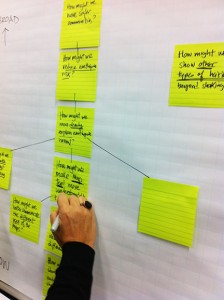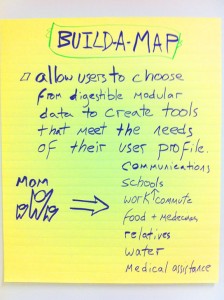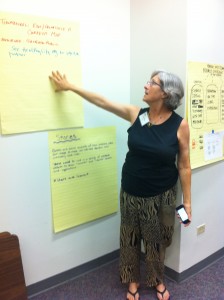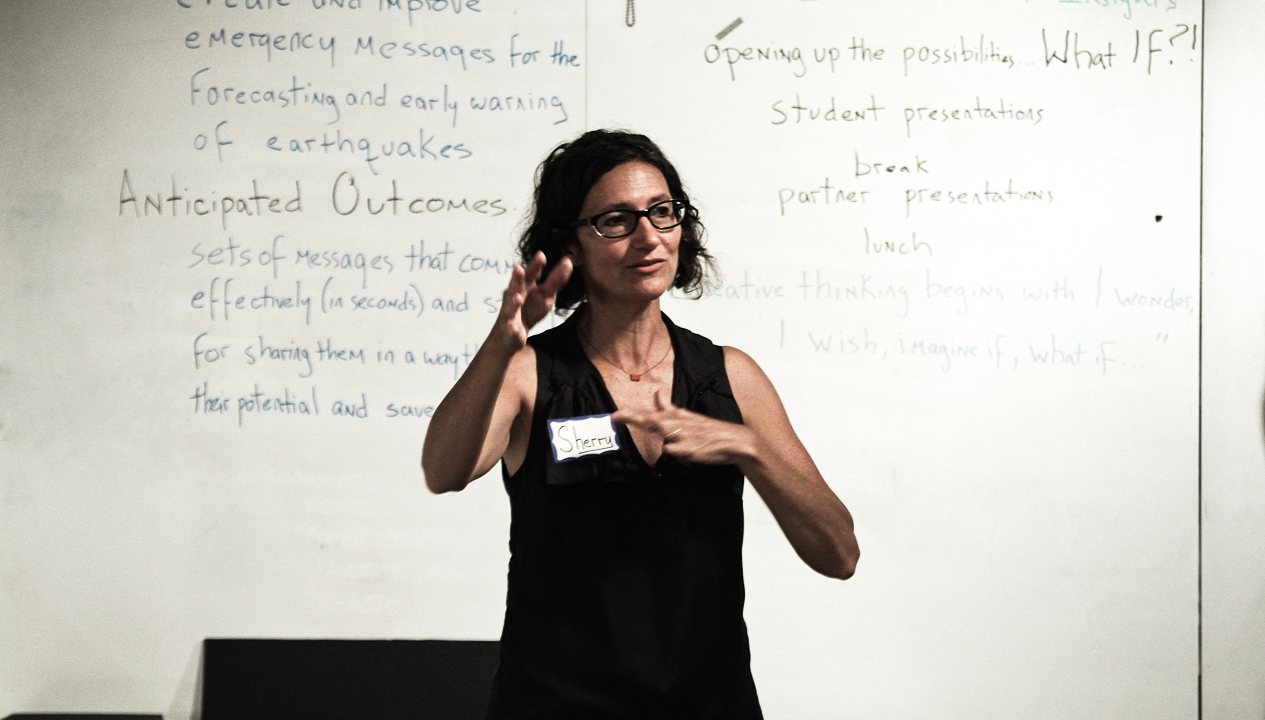Guest blogger Sherry Hoffman is a Research and Professional Practice faculty member at Art Center College of Design. Hoffman is also a founder and partner at (M)Arch. branded architectures, a collaboration of architects and creative marketing professionals.
I have had a lengthy engagement with the U.S. Geological Survey (USGS) and our Designmatters partners Lucy Jones and Sue Perry over the last several years, having led DesignStorms at Art Center, attended workshops, and contributed to the development of the Arkstorm Summit in Sacramento. Most recently, I was asked to participate, as Designmatters faculty, in a USGS workshop in Denver titled, New Audiences, New Products for the National Seismic Hazard & Design Maps. I was joined by a LEAP colleague and Art Center Alumna, Elizabeth Pastor of Humantific. Elizabeth and I were included in order to bring an outside perspective and to share our experience in design thinking and creative problem solving.
The purpose of the workshop was to launch a multi-year effort to expand the accessibility of the National Seismic Hazard Maps in order to save lives and protect property. The morning of Day 1 began with quick introductions to get to know each other and to gain an understanding and appreciation of the varied and relevant skills that we brought to the workshop (as a group we represented 17 different disciplines). After the introductions, Elizabeth asked the workshop participants if they had ever heard of design thinking. No one (except for me) raised their hands. She gave a brief overview to start the work of Day 1. The next morning of Day 2, I gave a brief presentation on the USGS 2-Day Design Storm last year as an example of the design thinking process. I talked about divergent and convergent thinking, the generative and iterative process, and guidelines for getting at the new. I also tried to emphasize that design thinking isn’t just for designers.
In between, there were technical presentations “About the Maps” followed by more social science presentations “About Humans” to give us the context for the workshop. By the first afternoon, I began to notice that there was an overlap in understanding and even somewhat in approach between the growing population of social scientists and the marketing and design professionals. Apparently in the past, the social scientists had often been the token “other” in the room. The consensus was loud and clear– “Know Thy Audience” and find out what is most important or what matters most to them. Then find a way to meet their needs and link earthquakes to that, to their everyday life. I participated on a panel with Lucy and others titled, Different Audiences Have Different Needs. My “aha” from that discussion, was that it isn’t necessary for the scientists to communicate everything they know, or to make sure that we understand their terminology, or even basic earthquake facts.
I discovered a new resource at the workshop or perhaps even a movement, “Plain Language”. Apparently, “It’s the Law” is a 2010 Plain Writing Act instituted by the Federal Government. The way they communicate it at www.plainlanguage.gov is a discussion for another Design Storm, but the gist of it is wonderful and relevant to this workshop. How might we use language that people can understand? This notion, which I have heard in different circles of “meet people where they are at”, reflects an overall shift and a different way of thinking about the science and communication. It is not dumbing down, but rather “smartening up”—clear, not simple.
My personal journey went from focusing on differences (and even some feelings of intimidation being surrounded by so many smart scientists) to focusing on the many commonalities (scientists also look for patterns and their process is often non-linear and messy too). The group, towards the end, began to cite design as a needed resource (albeit as a specific skill set, such as graphic design). In the afternoon of Day 2, I was in a small team with a social scientist (academic) and two USGS scientists. One of the scientists talked about how they were drawn to my proposal because it was open-ended while the others were much more specific and tied to agendas. I named my concept, “Build-A-Map”, which I can’t help but think helped in its initial appeal. I overheard other groups quickly talking about it as a reference point – either how it was similar or different.
Over the course of the two days, Elizabeth and I shared with each other the need to clarify before ideating as part of the creative problem solving methodology. I had just returned from the Creative Problem Institute Conference in Buffalo and one of Elizabeth’s colleagues was also there giving a presentation. Sue had a vision for this workshop and lots of relevant data was shared. It is sometimes difficult to then take the next step and formulate the challenge or identify the real challenge to invite solution and stimulate new thinking. Elizabeth suggested to me that perhaps we should create a challenge map to help organize and prioritize. At the end of the product pitches and teamwork, the proposal that gained the most support was to define the audiences and needs first.
This workshop was a milestone for USGS and many of its participants. It was another important step in bringing a diverse group of people into the conversation and to experience the process together as its own deliverable. The wrap-up from the group ranged from, “we need to find out what people want vs. what we want them to know” to “we need outside perspectives” and “there is value in inter-disciplinary work”.
How might national hazard science be used to make communities safer? How might we as a design community contribute? By being a part of the discussion and by engaging people across disciplines. By being both humble and bold as we continue to learn and expand our impact as catalysts for social change and innovation in order to change the world for the better.

